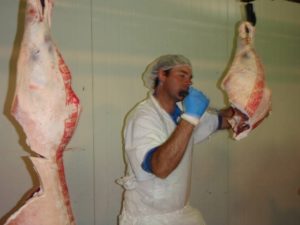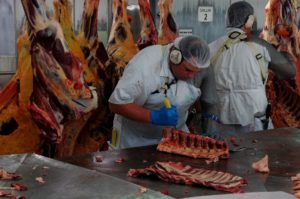Reducing the risks of working with a knife

Hazards and risks may arise from handling knives
© MINTRAC
What risks are associated with knifes use?
Knives are used across the whole meat industry. There are risks associated with the use of knives if they are not handled and used correctly and safely. Knives may cause injuries to the knife handler as well as those in close proximity to the knife handler.
The most common types of injuries are cuts and stab wounds. These often require medical attention and may need suturing, skin grafting and reattaching tendons.
How are risks associated with knives reduced to the lowest possible level?
Management takes a risk management approach to all situations in plants where knives are used. This includes:
- identifying the hazards associated with each task
- assessing the risks by identifying each of the factors that may have contributed to the risk
- identifying and implementing controls that reduce the risks to the lowest possible levels.
- Checking that the controls have reduced the risks and haven’t created any new risks.
What can workers do to reduce the risks of injury using knives?
Workers must receive training in the use of knives. You must always receive training and follow work instructions for the particular task you are doing. You should always concentrate when using a knife. You are most at risk of an accident when you are tired and not concentrating on the job you are doing. It is very easy to cut yourself when you become distracted or careless in your approach to work. There are some general principles about using knives safely. These include:
- don’t use a blunt knife as you will need to use more force which gives you less control
- never take your eyes off the cutting path of the knife, if you must look away, stop cutting
- never cut towards yourself or towards another individual
- if you drop your knife let it fall, don’t try to catch it
- always place your knife in the scabbard or pouch when not in use
- always be aware of the movement of people around you
- never fool around with a knife in your hand or fool around with others who may have a knife in their hand
- keep the handle of the knife clean and free of fat and grease at all times.
Personal protective equipment is a vital part of knife safety and workers should always use PPE when working with a knife. The PPE used at your plant will be set out in work instructions for the task. You must be trained in each task that you do and you must follow work instructions for that task. The range of PPE equipment used can include:
- mesh gloves
- mesh aprons
- cut resistant gloves
- arm guards.

Cut resistant mesh and rubber gloves reduce the risk of knife injury
© MINTRAC
How do you sharpen knives safely?
u should complete the unit of competency AMPX209 Sharpen knives and follow work instructions related to sharpening knives at your plant. Some general principles related sharpening knives include:
- when using a sharpening stone, make sure the stone is on a slip-proof, flat surface
- when using a stone, always keep your free hand away from the stone and knife
- make sure your steel has a safety guard between the handle and the body of the steel
- when using a grindstone, make sure the rotation of the stone and the cutting edge of the blade are away from your body.
